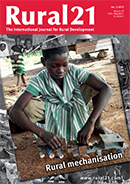Vol. 49 Nr. 2/2015: Rural mechanisation

It’s easy to find arguments in favour of raising the degree of farm mechanisation. People’s living conditions improve, for the drudgery that also makes farming so unattractive for young people is no longer necessary. Standardised, optimised processes along the entire value chain raise the quality of primary and processed goods; harvest and post-harvest losses are reduced. Furthermore, a services sector develops around production, marketing and the use and repair of technical equipment that creates jobs, boosting the economic power of rural areas. And last but not least, coupled with higher purchasing power, the quality and volume of food produced also improves the food situation of the population. However, even the finest technology will be of no use if it is not applied or not properly employed – perhaps because its operation or maintenance is too complicated, because it doesn’t fit into the societal context or sections of society – often women – are barred from using it, because farmers do not benefit from it or simply because they lack the (financial) resources. Our authors show why and how the individual regions throughout the world have developed differently in terms of mechanisation and which concepts are really forward-looking, i.e. sustainable with a view to climate change and scarce natural resources, and that are above all also suitable for smallholders.
Focus
- Rural mechanisation – where are we now, and where should we be going?
- A round tour of mechanisation
- Animal traction – potential and constraints
- Mechanisation – a catalyst for rural development in sub-Saharan Africa
- “Farmers have to get organised”
- Sustainable mechanisation – a hard row to hoe
- Solar pumps and drip irrigation help Indian farmers save water and energy
- Sorting out the cocoa maze with pole pruners
- Biodegradable mulch – a solution for small-scale horticulture?
- A food processing machine that makes a difference



